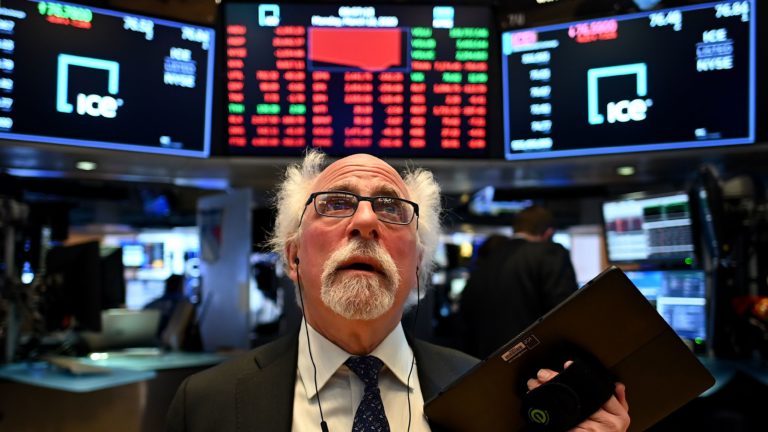Dow plunges 1,800 points, trading halted after fed slashes rates

Markets are falling sharply, even after the Federal Reserve aggressively cut interest rates to near zero. (Johannes Eisele/AFP via Getty Images)
Updated at 11:55 a.m. ET
U.S. stock indexes fell sharply Monday after the Federal Reserve aggressively cut interest rates to near zero in a bid to stop the economy from crashing. The Dow Jones Industrial Average was down about 1,800 points, or nearly 8%, as coronavirus measures rapidly expanded.
The S&P 500 index fell nearly 11% after temporary trading halts were lifted on the New York Stock Exchange, but later recovered somewhat to a drop of about 7%.
A 7% drop in the S&P 500 automatically forces trading to stop for 15 minutes, which has happened three times in the past week.
Earlier in the morning, the Dow dove more than 2,700 points, or nearly 12%. The plunge wiped out Friday’s nearly 2,000-point gain in the Dow.
The drops on Wall Street follow steep falls in Europe, where stock indexes were down as much as 11% Monday.
Oil prices fell 5% to about $30 per barrel. They’re down 50% so far this year.
Temporary government orders to close restaurants and bars in New York City, Los Angeles and Chicago and recommendations to ban groups of more than 50 people were among the latest attempts to stem the spread of the coronavirus.
On Sunday evening, the Fed took the extraordinary move of cutting rates by one percentage point to near zero. The last time it moved them that low was in 2008, during the financial crisis.
“The effects of the coronavirus will weigh on economic activity in the near term and pose risks to the economic outlook,” the Fed said in a statement.
The central bank’s policymaking committee said it “expects to maintain this target range until it is confident that the economy has weathered recent events and is on track to achieve [the Fed’s] maximum employment and price stability goals.”
In cutting its key interest to zero, the Fed has lost a major policy tool — one that it would need if the economy tumbles into recession. But the Fed said it will boost its holdings of Treasurys and other government securities by at least $700 billion. It took similar steps, known as quantitative easing, during the financial crisis.
The Fed said it’s “prepared to use its full range of tools to support the flow of credit to households and businesses.”

Source: Federal Reserve Board. (Hanzhang Jin/NPR)
Copyright 2020 NPR. To see more, visit https://www.npr.org.9(MDAzMzI1ODY3MDEyMzkzOTE3NjIxNDg3MQ001))




